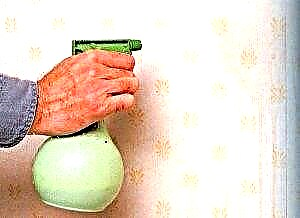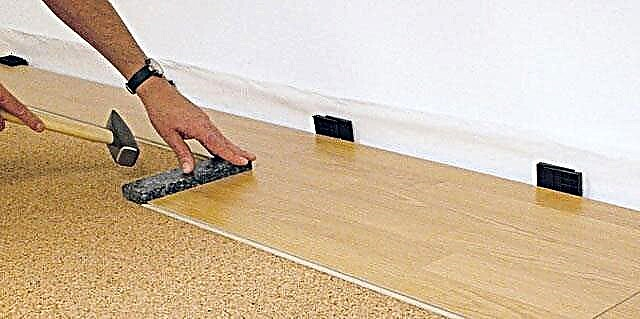As a rule, these are modern Iranian paintings, the ornaments of which reflect the thousand-year-old traditions of carpet weaving and the spirit of the ancient people of Persia.
Among the main features of carpet weaving in Persia, one can distinguish not only the excellent quality of weaving, but also the high density of knots using the best sheep’s wool and delicate silk.
Popular ornaments have always been medallions, natural motifs, famous story paintings or strict geometric shapes.
Our catalog contains square, rectangular, oval and round shapes of different sizes.
In the ANSY online store you can buy Persian rugs from manufacturers from Qom, Tabriz, Nain and Isfahan, as well as the famous lint-free kilims and sumacs.
Isfahan
Such Persian rugs belong to the Isfahan school, they are mainly made on a bright red or saturated blue background.
Their main distinguishing feature from other Iranian carpets is the high definition of the outline of the pattern. It is achieved due to the fact that the wool pile has a small length. As for the pattern, it both on the main field and on the curb consists of a dense floral ornament. In the center of such carpets, as a rule, medallions are located.
The prices for these carpets are different, you can buy both an expensive model and a model of the middle price category. It can be said that Isfahan carpets are copies of the works of Persian masters of the Safavid era. This era is the golden age of carpet weaving in the Middle East.
Tabriz
The color background of these handmade carpets is cream, blue or red. On these carpets battle scenes or falconry can be depicted. Often you can see the image of the plots of works of oriental poets. In addition, they often depict mosques and magnificent palaces. Unlike Isfahan carpets, on Tabriz, medallions are located not only in the center of the canvas, but also in the corners.
I must say that these carpets are very popular in European countries. They are in such great demand due to the two-sided pattern and low price. If we compare them with other traditional Iranian carpets, then the price of Gabe carpets is about half that. They are large and they depict large simple drawings. For their manufacture, unevenly colored wool is used. As for the ornament, it is quite original, its color shades have an interesting combination.
First, I must say that these carpets are an example of classic design. Mostly such products depict small flowers and interwoven branches. They are large and they depict large simple drawings. For their manufacture, unevenly colored wool is used. As for the ornament, it is quite original, its color shades have an interesting combination.
The main material for their manufacture is cotton. As a rule, the shades of such carpets are light, the patterns are characteristic light green, lettuce or blue. But nevertheless, a distinctive feature of the masters of Nain, is to perfectly combine blue with ivory.
For these carpets, a characteristic low pile, which has a pleasant silk texture. Carpets have a huge variety of color shades, they can be beige-brown, light green with a turquoise tint, as well as ivory. It must be said that only in one and the only region of Iran are carpets made, the price of which is higher than that of a product from combined or woolen threads, Qum is this region. For these carpets a characteristic diverse ornament. The image on the carpet is divided into squares, each of which is decorated with a floral pattern.
Persian rugs

In many interiors, the carpet is the main decorative decoration. In addition to attractive appearance, these products have functional qualities. Carpets protect the flooring from mechanical damage and all kinds of scratches. Often, expensive and elite carpets are used to decorate modern interiors. These types include Persian products that have long gained popularity around the world.

Features
Persia is an ancient country, about which many of us heard in childhood from fairy tales. Each of us has come across more than once such a concept as “Persian carpet”. Currently, this name refers to products from Iran. It was this country that was part of ancient Persia.
Carpet is an essential attribute of any home., and it is he who points to the welfare of the homeowner. Previously, a family that could not afford to decorate the floor with such a product belonged to the lower class in the eyes of neighbors. Real Persian rugs are inextricably linked with the history of the ancient country. The art of creating these paintings has been handed down from generation to generation. It was a carpet product that was considered the true value of the family. These expensive paintings from Persia became known to the world in the III century BC. e. At this time, the local population began to produce carpets for sale.

It is worth noting that medieval Persian rugs were considered an important attribute, which testified to the wealth and nobility of the family. Hand-made canvases were available only to representatives of high society.
As for the present time, the art of carpet weaving, fortunately, has been preserved. Some Iranian families still pass on the secrets of ancient masters from generation to generation.
A distinctive feature of Persian carpets is their appearance. Most often, the design is dominated by plant and animal motifs. Another distinctive feature of the products is the contrast.
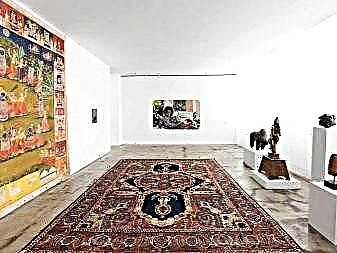
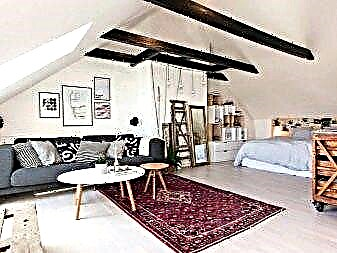
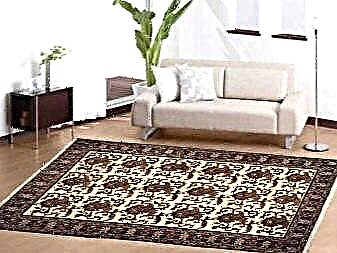

Modern Iranian carpets can differ among themselves in some qualities. The first factor is the name. It is selected depending on the area where the product is manufactured. Another difference is the material used for the base. Most often, high-quality camel or sheep wool is used for these purposes.
It is worth paying attention to the carpet pattern:
- One of its types is keledast. A characteristic feature of such a carpet is the presence of a hexagon, which is located in the central part. To create products, dense and soft wool is used.
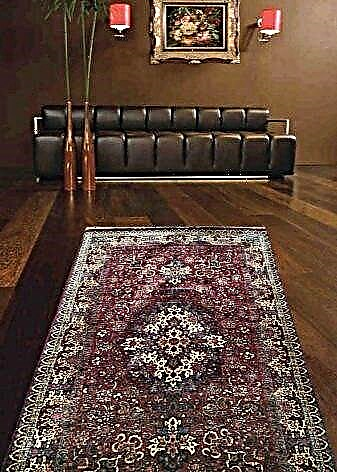
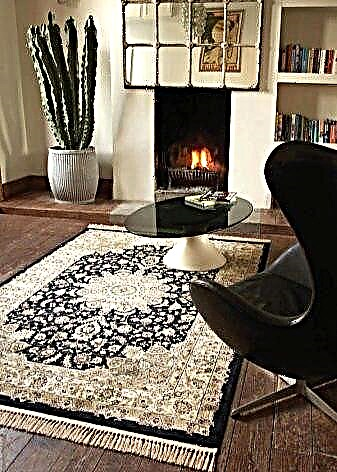
- The next version of the image is the canopy. - these canvases are distinguished by brightness and contrast. To create them, high quality material is used. These carpets are considered the most refined and elegant.
As already noted above, the appearance of the product can determine the location in which it was manufactured.
- Woolen cloths Tabriz possess original and meaningful ornaments. A distinctive feature of these paintings is the presence of a red or blue background. In the design of pile carpets, complex images and motifs are used.


- The most popular in Europe is a kind of carpet like Isfahan. In comparison with the previous type, small and complex elements prevail in the design of these products. The contours of the drawings can be traced quite clearly due to the fact that the pile is cut very short.
- Particular attention must be paid to Kum products. They differ significantly in design from previous options, as in the design you can see unusual color combinations. Such prints give an attractive appearance to the product. A distinctive feature of these carpets is the use of silk pile.


- To create Nain products thin cotton is used, painted in ivory and complemented by shades of blue.
- A separate view is rustic wares Gabe. These two-sided Persian rugs made by hand are very popular in Europe.
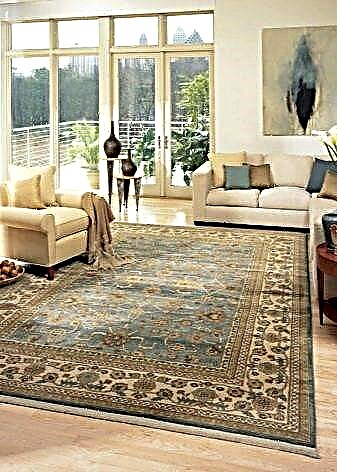

Forms
Persian rugs, like any other product, can differ in shape. For large living rooms and halls, square or rectangular models are suitable. Oval carpets will help to decorate a small room. But it is worthwhile to understand that the larger it is, the higher its value.
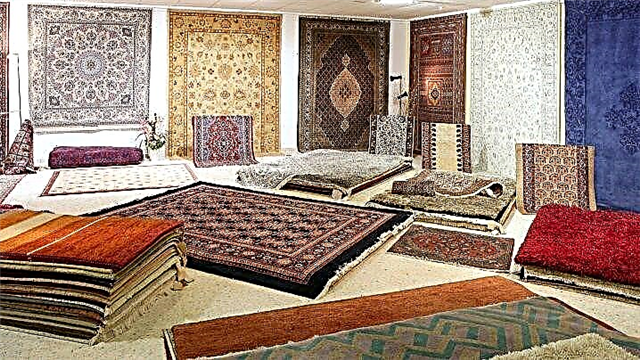
Iranian manufacturers produce products of various shapes and sizes. But even the smallest hand-made options are quite impressive in value.
Often carpets are used solely as a decoration of a room. Products can be safely laid on the floor and not worry that it will lose its appearance. Iranian paintings are quite resistant to various types of exposure and are durable.

Materials
Most often, high-quality natural sheep wool is used to create Persian carpets. The use of such a material provides good density and softness of the product. In addition, they turn out to be warm enough, which is one of their main advantages. Natural dyes are used to colorize the coat. Often for these purposes, various vegetables with herbs, plant shells are used. To fix the color on the material, citric acid is used. Caustic soda also helps in this matter.
The use of natural dyes provides the brightness and resistance of the canvas to fading. Of particular value are silk products. Natural material provides a soft and beautiful overflow coating. This is especially noticeable if the carpet was created manually. Persian tapestry carpets can become the main decoration of a spacious hall.
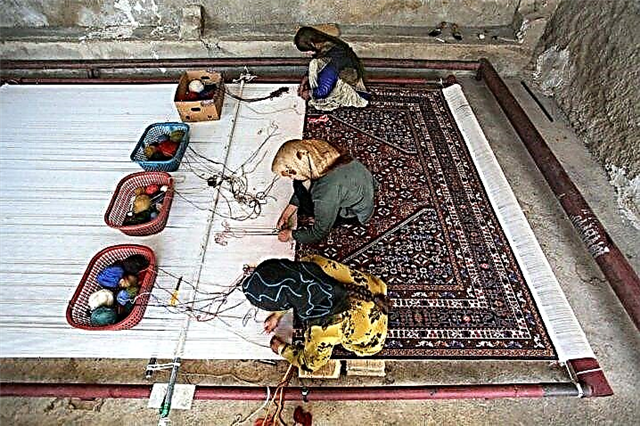
Colors
An important point is the color composition at the base of the carpet. One of the main advantages of Iranian carpets lies precisely in the unique range and combination of unusual palettes. Deep colors combine favorably with gentle and warm colors. Products with a peach background complemented by rich colors look expensive and elegant.
As noted above, contrasting colors dominate the design of carpets. Red, blue, black - all these colors are perfectly combined with each other. Natural dyes, with which this effect is achieved, provide brightness and color saturation of the product.


Particular attention must be paid to the ornament of paintings. The design uses plant and animal motifs, complex patterns, which are certain symbols. For example, in the plots of Persian carpets medallions representing the moon are often found.
A feature of some species is the presence of a contrasting border. Basically, this part is always separated from the center by brighter and more saturated patterns.
The Persian Kum rugs mentioned above use the most original color combinations. Beige is combined with brown, green with a turquoise hue. Products in this design always look expensive and elegant.
Gabe's rustic rugs have a rich color scheme. When creating these products, the ornament is always clearly drawn.
How to choose?
When choosing a Persian rug on the floor, you need to pay attention to several significant points. This is especially true when you want to buy a handmade product. First you need to check the density of the canvas. All nodes should be smooth, located exactly in one row.
Modern Iranian manufacturers place special designations on them “hand made”. This indicates that the product is made by hand. Machine knitting of carpets is also indicated by a certain marking. Pay attention to the front and back sides of the canvas. They must be identical in design. Another important point is fringe. On real Persian rugs, these elements are not stitched.


No matter how surprising it may sound, original products may have defects. This is due to the fact that the carpet is created manually, and any master can allow a small oversight in the work. Often, defects are manifested in the asymmetry of the nodules. Pay special attention to the absence of stitches made by the machine at the place where the base of the canvas and the brush are fixed.
Many experts say that a good carpet can be easily identified by such characteristics:
- the complexity of the picture. The more intricate and original the pattern, the better the product,
- material quality. Wool should not remain in the palm of your hand after touching it.
- the presence of the plot. The most interesting motifs are handmade designer carpets.
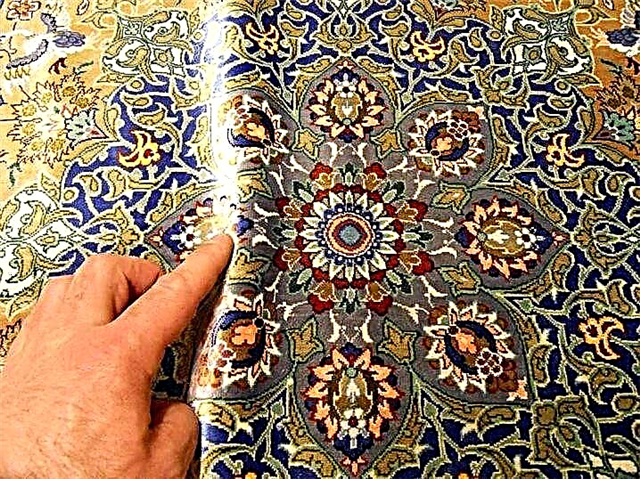
Please note that this material is always soft, smooth and shiny. Quality wool quickly and easily absorbs dyes. If you used cheap material to create, the color will not be so saturated.
Equally important is the quality of weaving. Many buyers rely on the fact that the same number of knots on the outside and the wrong side is an indicator of the originality of the carpet, but this is far from the case. The quality of weaving depends on many factors. The main role here is played by the number of knots and time.

How to care?
Despite the high quality and durability of Iranian carpets, none of the product owners are safe from such a problem as the appearance of stains on the surface. Dust and sand falling on the canvas affect the quality of the pile. Also, dirt has a negative effect on the color of the carpet. In order to avoid such problems, it is necessary to familiarize yourself with some important features for the care of the product. To begin with, it should be said that carpets are not recommended for use in rooms with a high level of humidity. The surface of the Persian canvas should not be affected by chemical toxic substances.

Using a carpet in the room, it is necessary to take into account the fact that objects with sharp legs cannot be placed on it. This is especially true of the furniture and those decorative elements in which these elements are made of metal. To prevent uneven wear, changing the position of the product will help.
Do not use warm or cold air to dry Persian products. This can negatively affect the structure of the pile. If you spilled even a small amount of liquid on the canvas, you must immediately remove the stain. Otherwise, moisture is absorbed into the base and spoil the appearance of an expensive carpet.

Options in the interior
The main advantage of Persian carpets is that Iranian manufacturers managed to preserve ancient traditions in their design and introduce elements of modernity. Often, such products are used in classic interiors. The low-key English living room can be harmoniously complemented by a luxurious Persian rug. Flowers and plant elements present in the ornament will complement the conservative and sophisticated atmosphere.
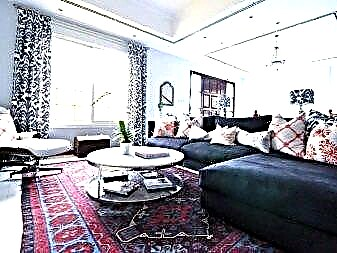
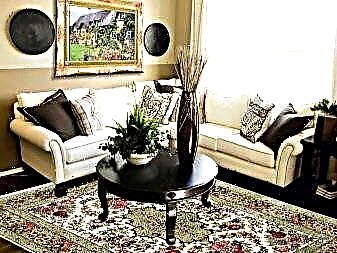


Many modern designers are not limited to the classic style. Often, Persian rugs can be found in such an interesting direction as a loft. But not quite ordinary products are used to decorate the interior. Most often, the decor is complemented by a carpet created using patchwork technology.

Persian canvases will be a great addition to any interior made in the spirit of minimalism. Such products are advantageously combined with decorative elements, and also make the atmosphere more comfortable and cozy.

Persian rugs are often used for oriental interiors. In such an environment, the Persian canvas looks as harmonious as possible. You can complement the oriental decor with a carpet in contrasting colors.

An overview of handmade Persian rugs, see the next video.
Persian Carpet History
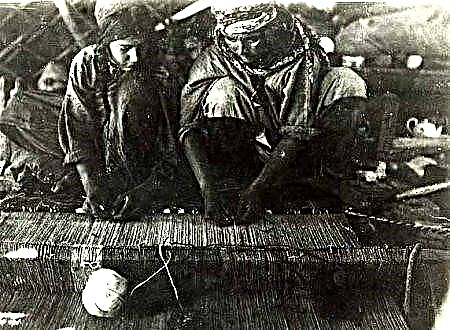
In the East, from ancient times, the carpet was attributed to the attributes inherent in paradise. Therefore, no respected house was conceived without a carpet, moreover, the number of carpets with which he decorated his house was considered a measure of a person's wealth. Only the shame and disapproval of the neighbors was a family who could not lay at least one carpet on the floor in their own house. Therefore, the history of Persian carpets is very ancient and instructive.
From the earliest times, the art of carpet weaving was an important family value, carefully transmitted from older generations to younger ones. Antique Persian rugs were made directly at home and were intended for home use or as a gift. But from the 3rd century AD, workshops appeared in Persia, in which craftsmen began to weave carpets for sale. In fact, the study of the history of the Persian carpet will be a study of the path of development of the great ancient civilization of the Persians.
A number of historians suggest that carpets were invented by nomads migrating through Central Asia. For a nomad, the carpet served as an indispensable household item, because he protected it from dampness and cold, they could hang the entrance to the tent, throw it on the floor. Gradually, the lines and patterns of products became more interesting, intricate and sophisticated, and the carpet from an ordinary household item turned into a luxury item, the owners of which were sought above all by the upper layers of the then Persian society, who were not too worried about the cost of the Persian carpet.
According to scientists, the oldest carpets that have survived to this day are around 2400-2500 years old. The oldest antique Persian rugdated V century BC e., found in 1949 an archaeological expedition led by S. Rudenko during excavations in the Altai mound of the Scythian king. Moreover Pazyryk carpet (as they called it) perfectly preserved thanks to ... robbers. They in ancient times sacked the mound, taking everything valuable from there and leaving only a bulky and heavy carpet. They didn’t even bury the burial ground in their thoughts, therefore, water began to flow there, with which the carpet was soaked and frozen in permafrost, therefore it did not rot over the centuries. Only because of this, this unique artifact adorns the collection of the St. Petersburg Hermitage with its bright colors.

Later, Islam came to Persia, according to which it was forbidden to depict any living creations of Allah. Then horses, camels and birds disappeared from the carpets, and the carpets, in accordance with the Qur'an, were covered with abstractions and ornaments. For the initiates, the Persian carpet became a kind of book in which the decorating pattern tells about the structure of the universe.
In 1038-1194, Turkey was ruled by Turks, who had their own carpet-making culture, so this period was a time of an active exchange of carpet-making techniques and skills.

After the Turks, Persia was owned by the Mongol tribes until the middle of the 15th century. Carpets made during this period lost true Persian splendor, and their decoration was reduced to the simplest, most often geometric ornaments.
During the reign of the Safavids dynasty (XV century), the capital of Persia moved to Isfahan. State workshops appeared in it and in a number of other cities, in which the best masters of carpet weaving created real works of art. The religious ban on the depiction of birds and animals was lifted, and carpet production became a significant source of income for the state treasury. Carpets from Persia very quickly became popular in Europe, which sent large trading expeditions after them to the east. At that time, in the best execution of the Persian carpet, the flowers and the ornate system of stems were changed to a complex star medallion, located on a bright blue background.
During the wars with Turkey, Afghanistan and the Russian Empire, the high art of Persian carpet weaving was actually lost, and only nomads in remote villages retained the traditional skills of manufacturing these products. Only in the 19th century did the Persian carpet weaving flourish again, and again did their export become a significant budget item in the country.

Classification of Persian Carpets
Today, Iran, where Persian carpets are made, is their largest producer, producing more of them than all other carpet weaving centers in total. Each city, whether it is Tabriz, Nain, Isfahan, Qum or Gabe, has its own special secrets of carpet making, so Iran now produces a variety of carpets.
It is enough for a specialist to look at the carpet to determine exactly what types of Persian carpets are, that is, in which corner of Iran it was produced. Any details are important: the background colors and ornaments used, the base material and the quality of the wool, the type of knot and the density of the product.
Unique wool

The creators of Persian rugs for the most part work with sheep's wool, which alone cannot provide a wide color palette. Suits of sheep allow you to get white, gray, yellow, tan and brown wool from them. In different parts of the body of the sheep, wool of different qualities grows. Up to 10 varieties of wool can be sheared from a sheep alone, so specialists carefully work on their dismantling after shearing.
Sometimes Iran supplies carpets for comfort made of woven shreds - they look quite original and quite colorful.
To understand the quality of wool, experts recommend doing this: scrub the surface of the carpet with your fingers and look at them - if there are separate fibers of wool on the fingers, then it is of average quality, but if the hand becomes “hairy”, then you should not buy such a carpet at all .
Wool dyeing

For dyeing wool, mainly natural dyes obtained from vegetables, herbs and various tree species are used. In addition, it can be painted with walnut shells, madder roots, asparagus stems, grape leaves, sour milk and pomegranate peel.
Traditionally, carpet weaving masters themselves prepared natural dyes, receiving red from a cochineal beetle, blue from oak bark or leaves of an indigo, yellow from saffron and grape leaves, green from safflower or buckthorn, and black from pomegranate peel.
In the process of dyeing, citric acid or caustic soda is also used, which are necessary for the chemical fixation of the dye on the fibers of the wool so that it is not quickly wiped or washed.

Quality wool - shiny, smooth, soft to the touch. Soft high-quality wool is better impregnated with dyes than coarser, so the brightness of the pattern and color fastness of the product are already laid here. Elite Persian carpets made of silk shine and shimmer in the light.
Persian carpets, woven until about 1900, were always painted only with vegetable dyes, but later wool was dyed with a “Swiss dye” and chrome compounds. If natural dyes fade over time and acquire a slightly greenish tint, then synthetic dyes do not change from time to time.
Differences between hand and machine made carpets

Unfortunately, Iran now sells not only hand-made products, but more and more industrial products have also begun to be found. To meet the growing demand in the world, Iranian machine-made wool carpets began to be produced in an increasing volume, the production of which uses synthetic materials and dyes, machine printing, and artificial aging. Such a carpet measuring 2x3 meters costs only 250-300 dollars, but you can not call it Persian, although it was made in Iran.
Even with the same quality of raw materials, handmade carpets will cost an order of magnitude more expensive than Iranian machine carpets. This is mainly due to the incredible complexity of the manual process. In addition, manually knotted knots are always slightly different, have a unique shape, in addition there are several types of knots used in the manufacture of carpets. Therefore, there simply cannot be two identical handmade carpets, even if they are made according to one sketch. The irregular, slightly uneven shape of the knots gives the handmade carpets a special charm. But the car makes perfect carpets without flaws, but they all turn out exactly the same.
But more importantly, the machine is unable to fix the pile of the carpet with the help of knots, it just pierces the loop of the pile between the weft and the base, so handmade products are much more durable and durable.

The work of a weaver over the millennia has not changed - for years he has to tie and tie endless knots. Experienced craftsmen or craftswomen are able to tie up to 10,000 - 12,000 knots per day. It seems a lot, but it should be borne in mind that the best silk Persian rugs per square meter have a minimum of a million knots. Therefore, it turns out that a similar carpet measuring 2x3 meters a pair of weavers will weave for a year.
The craftsmen weaving the carpet work only in the shade under sunlight, otherwise they can mix up the threads and take a slightly different shade. They say that having made one carpet, a person parted with half of the diopter of the eye.
To make sure that this is a real Persian carpet of Iran handmade, you need to turn it over and look at its back side. From the inside, the loops will be clearly visible, the product will be flexible, without creases, and the ends of the threads will not be sewn by machine stitching, but woven into the fabric.

From the inside of the handmade carpet, the colors and pattern will be clean, while in the machine carpet the pattern will be blurry.
Carpet manufacturing technology
- First, the artist draws on paper a sketch the size of a quarter of the product, and then completes the drawing with a symmetrical overlay.
- After that, the sketch is painted and transferred to graph paper.

- This scheme is transmitted to the master, who makes a carpet through it.
- The base is pulled onto a wooden frame and the long process of weaving a pile into it begins.

- Each thread must be fixed with a special knot, for each of which the master spends about 2 seconds.
Hints on the drawing begin to appear only after about a month after the beginning of such painstaking work. The quality of the material, the complexity of the pattern and the subtlety of the master's work affect the weaving speed.
The number of knots per square meter determines the quality of the carpet: it is obvious that the more they are, the stronger and denser the carpet will be, the clearer its pattern, the cost of the Persian carpet will increase accordingly.
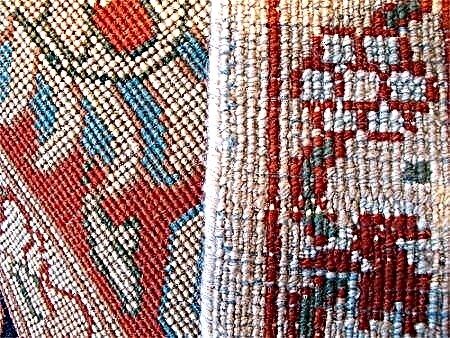
But a too-dense carpet also has its weaknesses - if it is too tightly folded, then it can crack on bends.
The density of high-quality Persian carpets is 1.5-2 million knots / sq. m. It is desirable that the nodules are arranged in an orderly and even manner. It is much easier to tie a thin knot with thin children's fingers, which is why teenage girls are traditionally used as weavers. A handmade carpet takes time from a master from several months to three years.
- Weaving the next 7-10 centimeters of the carpet, the craftswoman carefully cuts the pile, leaving 20-25 mm of its length. Only after this, from the chaotic interweaving of multi-colored threads, the pattern made will appear.

- When the carpet is finally ready, the master processes it with a special tool and makes a fringe.


- At the final stage of manufacturing, carpets are washed, which, among other things, allows you to verify the quality of work.
In former times, a new carpet was laid in the sand across the road along which camel caravan went. Then, well-worn carpets were washed for a long time in running water, and then dried under the scorching sun. From all these difficult tests, the carpet only got better: the pile was divided into finer fibers, making the carpet more flexible, soft and fluffy. And for the mechanical durability of the carpet, as well as the durability of the dyes, the old masters did not worry, because they were reliable. But if the quality of the carpet was inadequate, then similar severe tests were immediately revealed in it in the form of defects in the carpet weaving itself or in the quality of the dyes used.
Now the process has been somewhat simplified, but until now, new carpets are necessarily washed and dried, after which they become more plastic, and their too bright colors are slightly muffled.
- Instead of medieval camels and pedestrians, today they use a vibration stand on which the carpet is mechanically fluttered. With such modern processing, the product becomes soft and plastic in just an hour.
In the old days they had to lie on the road for 3 months.
Video on the manufacture and variety of Persian (Iranian) carpets:
The cost of a quality Persian carpet

It is clear that hand-made carpets are valued far above machine-made carpets. They can even be used as an investment, since their prices are growing steadily. Those who are interested in how much the Persian carpet costs are unlikely to please - the price of a silk carpet 2x3 meters in Moscow is $ 60,000. Prices for round Iranian carpets in recent years have doubled and their growth continues. After silk, wool carpets are considered the most valuable. The cost of the product is affected by the complexity of the pattern: the more complex it is, the more expensive the carpet.
As for the prices for exclusive "Persians" of manual manufacture, they are measured by numbers with seven zeros. For example, a silk “kilim” embroidered with gold threads left the Christie auction for $ 1,400,000, and 2.5 million were easily given away for the perfectly preserved “tabriz” of the 19th century.

In the year of Persian rugs sold for several hundred million dollars. This market segment is not so large, as it is elitist, and buyers live mainly in the USA and Europe. But, despite significant prices and limited demand, manufacturers cannot keep up with it.
In recent years, Iran has undergone rapid economic development: it has appeared its own aircraft and automotive, energy, petrochemical industry, housing and roads. All this requires working hands, and they pay much more in these industries than carpet manufacturers. In this regard, young people began to leave the historical centers of carpet weaving, looking for better prospects. Therefore, together with the elderly, the manual traditions of carpet weaving are gradually dying, and less and less handmade carpets are entering the market.
Therefore, in recent years, prices for carpets of famous Iranian masters have jumped many times, but even against this background it is becoming more and more difficult to order such a carpet.
Do you like Persian rugs? Which of their history and manufacturing methods has impressed you the most? Tell us about it in the comments.
You will be interested in:
If the floor is clean before entering, this means that inside they care about cleanliness and respect the guests. It is possible to achieve cleanliness in the old fashioned way, constantly tearing floors with a wet rag, but this ...
Almost every home on the floor has some kind of textile products, but not all families have modern cleaning vacuum cleaners. That's why the task is how to clean the carpet ...
Pets bring joy to people, but with them a lot of trouble. Almost all owners of animals with rich fur, including cats, have to regularly remove from ...
Floor carpets have a wide range due to many factors, including the length of the pile. In some modern products, it reaches five centimeters.

